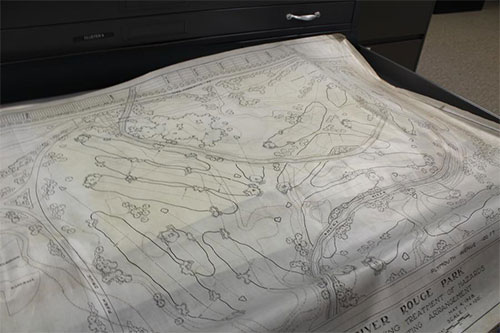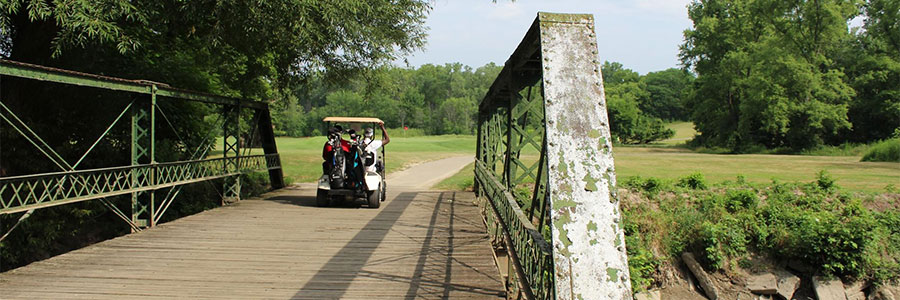WDET listener, Jeff Currier, is a 32-year-old golf enthusiast from Ferndale.
He asked CuriosiD: “Who Designed the Rouge Park Golf Course?”
Article by Laura Herberg, Community Reporter WDTE.org (September 4, 2018)

With the help of Andrea Gallucci, an archivist at the City of Detroit, WDET found a map of the Rouge Park Golf Course from 1928. But, unfortunately, it did not indicate who designed the Rouge Park Golf Course.
It’s not unheard of for a golf course’s designer to be unknown. Of 84 courses known to have been built in Michigan between 1921-1930, the designers of 37 appear to be unidentified, according to a list on Michigan Golfer. This could be because records were destroyed, a designer backed out, or the course might have been designed by a city employee.
But WDET is not giving up the search! A document indicating the designer of the Rouge Park Golf Course may be out there. Read through the steps we took in trying to answer this question, and then let us know if you have any theories or leads by commenting on this post or leaving a voicemail at (248) 660-9338.
THE COURSE
In 1923, the city of Detroit acquired land for what was — and still is — the largest park in the city: Rouge Park. Plans for the development of the natural area included amenities like swimming pools, walking trails, and 18 holes of golf.
A May 15, 1927 story published in the Detroit Free Press provided this description: “An 18-hole golf course, to be the finest public links in the city, is now under construction and will be open to the public within a year or so. This new golf course, being built over the rolling terrain of the park, with many sporty holes across water, up hill and down dale, is expected to relieve the congestion on the other municipal courses besides being one of the finest courses, public or private in the district.”
The first nine holes of the course were completed in 1928, the next in 1929. Today, the par 72 course is one of three city-owned courses currently in operation, along with Rackham and Chandler Park.
The Rouge course is known for being affordable, approachable for beginners, yet still interesting for experienced golfers. The Rouge River and wooded areas not only create obstacles for golfers but a haven for wildlife. On a tour of the course, WDET spotted a bunny and what appeared to be a groundhog.
WAS IT DONALD ROSS?
The most popular theory about the course’s architect is that it was a famous, Scottish-born golf architect named Donald Ross.
A course review posted on the website GolfBlogger on July 11, 2011 proclaimed, “I ventured into Detroit to the Rouge Park Golf Course on the promise of a Donald Ross course.” Adding later in the review that “the greens all are stereotypically Ross. They’re small, round, and crowned.”
A reviewer on TripAdvisor called the Rouge Park Golf Course a “Nice Old Donald Ross Course.”
When WDET spoke to Detroit Historian Ken Coleman, he says he thought Ross designed it because the golf architect was active in the area around the time the Rouge was built.
Ross, as a designer, was prolific. He is credited with designing more than 400 golf courses nationwide, primarily from early 1900 through the 1930s. In a map created by WDET of golf courses built in Southeast Michigan between 1921-1930 (based on information from Michigan Golfer), the Rouge Park Golf Course is surrounded by courses known to be designed by Ross.
Golf architect Raymond Hearn is familiar with the Rouge Park Golf Course because his company recently sent the city of Detroit a proposal to redesign it.
Of the course, Hearn says, “It is classic in the sense that its lay-of-the land design. Whoever designed it used the land pretty well.”
Hearn admits this is a Ross trait, but he also says it was typical of many other designers active during Ross’s time.
Overall Hearn says the Rouge Park course is nice but, “It’s not this classical gem that has never been discovered yet by someone that’s the Rembrandt or the Picasso sitting in the corner of the attic with dust on it.”
Bradley Klein, the architecture editor for Golf Channel and author of Discovering Donald Ross: The Architect and his Golf Courses says, “In many cases you don’t know you’re on a Ross course because it’s become overgrown with trees or the greens have gotten rounded off, or the bunkers have lost their shape. Even his best-designed courses have evolved dramatically [since they were first built].”
GIVE ME PROOF
“The best way to know you’re on a Donald Ross course,” says Klein, “is there’s evidence.” In other words, you know who the designer is when it’s documented in course plans, meeting minutes, newspapers or letters.
Karen Peek, director of operations at Golf Detroit, the company contracted by the city since March to run the Rouge Park Golf Course says the question of who designed it is one that’s been asked over and over again.
“I don’t have a definitive answer for you,” Peek says. “It’s unfortunate that no one documented who it was.”
Peek previously worked for American Golf, a national company that managed the Rouge and other Detroit-owned courses for about 20 years. Back in the early 1990s, she says, American Golf tried to figure out who had designed the Rouge Park course.
“There was a significant amount of research that went on during that time to identify some of the selling points, anything of notoriety about these golf courses.” But, she says, the research did not turn up the Rouge course’s designer.
Additionally, the course is not on the official list of Ross-designed courses maintained by the Donald Ross Society. Nor is there any record of it in the Donald Ross collection in the Tufts Archives in North Carolina.
A search in newspaper archives from the 1920s turned up several references to the park and the course, yet none mentioned a course designer, Ross or otherwise.

